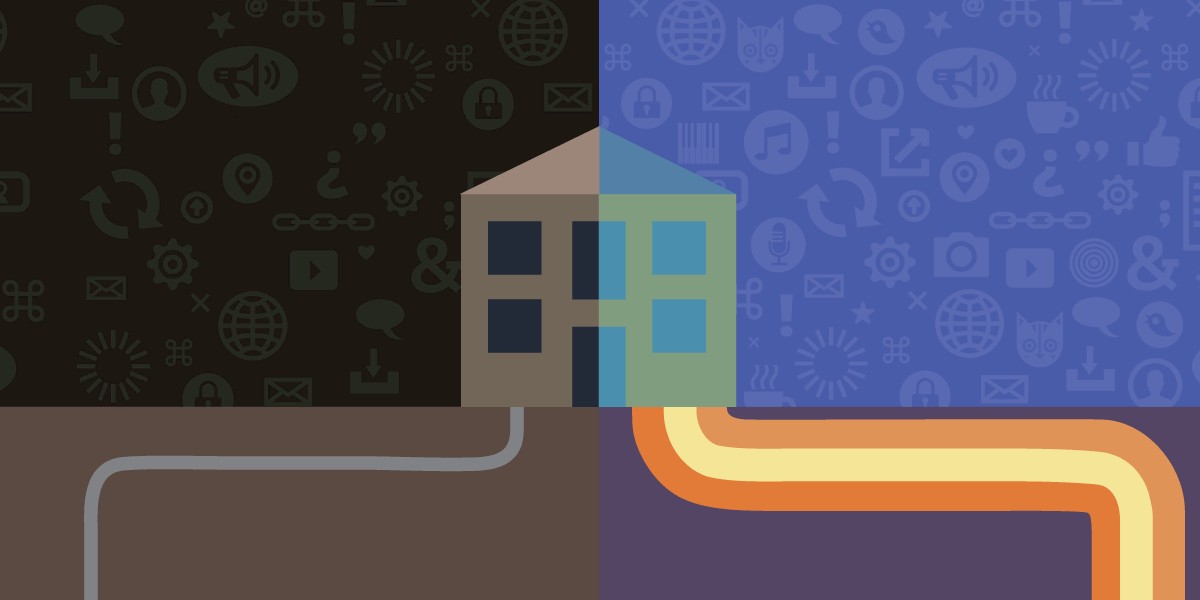Earlier this year, EFF noted that the United States is facing a high-speed broadband access crisis. For the foreseeable future, it appears that a supermajority of Americans will not have access to fiber to the home. Instead, it is cable monopolies or nothing at all.
Government data indicates that this problem is particularly pronounced in low-income neighborhoods and rural markets. But this future is not set in stone. We support efforts to aggressively meet this challenge so that this generation can benefit from affordable, universally accessible, competitive high-speed broadband access.
This year we have worked hard to unwind much of the damage the incumbent telecom industry cause through laws they’ve pushed over the last decade. We also conducted and published research to educate policymakers.
For example, we have shared our most recent findings that fiber is so vastly superior to all of its alternatives in wireless (including 5G) and cable as a data transmission medium that only universal fiber to the home will ensure a network viable for decades of growth. Our paper shows that claims made by industry that 5G or cable are sufficient are just tactics to prevent legislators from demanding what people need and deserve.
The Rest of the World Marches Ahead While Our Current Federal Approach Repeatedly Fails
Every country that is ahead of the United States got there because government policies promoted competition, universality, affordability, and high-speed access. In the U.S. though, the FCC pursues a policy of total deregulation of the broadband access market through the Restoring Internet Freedom Order and greenlighting blatantly anti-competitive mergers like Sprint and T-Mobile. AT&T kicked off this year by just relabeling their wireless 4G services as 5G and calling it a day while simultaneously ending their fiber to the home construction efforts (Verizon stopped years ago) when the government mandate to build fiber expired, which is significant given that half of the fiber to the home construction for 2018 was by AT&T.
Policymakers in Washington, D.C. finally caught on to how far behind the U.S. is and why. The House Energy and Commerce Committee is openly debating spending billions on broadband infrastructure under the LIFT Act, although it has admittedly not fully committed to making it a gigabit future to match our international counterparts. The House of Representatives voted to put the FCC back on the job with the passage of the Save the Net Act and it awaits a vote in the U.S. Senate. And the FCC has made correct calls on spectrum policy and could potentially raise billions Congress can invest into fiber infrastructure while also expanding access to unlicensed spectrum, which will improve WiFi routers and small ISP access to high-speed wireless services. But all of these await action by Congress, support by the president, and for a federal agency to enforce competition and universal access policies already required under federal law. So long as these languish, the limited federal efforts to improve our fiber infrastructure situation will continue to remain inadequate.
The Bright Spots in Our Broadband Future is Coming from the States and Localities
At the state and local level substantial progress is being made to chart their own future. California’s legislature allowed an AT&T and Comcast law (Public Utilities Code 710) that prohibited the California Public Utilities Commission from addressing their monopolies after strong opposition from EFF and other consumer groups. Shortly following this major victory for Internet users, Governor Newsom announced plans to begin crafting a “Broadband for All” initiative that EFF supports so long as it is pursuing universal fiber access and a gigabit future. We believe this state’s lack of a broadband plan has contributed heavily to the fact that most of us that live here have monopolies or no access at all for high-speed access (with the exception of San Francisco). There is no good reason California is so far behind its international competitors, and EFF has been working with fiber experts and advocating to California ways to not just catch up to South Korea but to become number one in the world.
In other states, we are seeing progress driven by local leaders and citizens who demand more than the abysmal service they are offered. Utah is proving to be a hotbed of forward-thinking activity with the consistent expansion of an open-access fiber network run by local cities called Utopia where residents enjoy 11 options for gigabit service. This type of approach to broadband infrastructure where the government builds the wires but someone else sells the broadband service holds tremendous promise. One study predicts a structurally separated network deployment could connect rural homes to fiber without low-interest long term financing and new open-access fiber deployments are cropping up such as the multi-city effort of Neighborly.
Alabama recently made changes to its state laws to allow for the recent announcement by C-Spire to deploy fiber to the home through a joint venture with the electric utility. And in Colorado voters are repeatedly approving community broadband solutions with Fort Collins deploying municipal gigabit broadband at $60 a month. As each state and local communities rises up to demand more from their elected officials, we expect more progress to connect the nation.
What Happens If We Fail to Take on This National Challenge Very Soon?
Quite simply, if we do not build an infrastructure ready for the future Internet, then it will not be accessible to us. The next generation of applications and services that need high-speeds and low latency will just not work well for a great number of Americans. Testbeds for innovation will exist overseas where technology companies will have large local populations of high-speed users with access to near-instantaneous gigabit and 10-gigabit connections (and beyond) will be the norm while Americans spend 300% above market rates for their Comcast line. There is very little reason to expect the future Silicon Valley to be in the United States if we allow our telecom infrastructure to be bogged down by yesterday’s infrastructure.
But more importantly, without a new commitment to the universality of future broadband access, then the digital divide of today will substantially worsen. Americans with little money will be forced to pay monopoly rates for an essential service while wealthy Americans will enjoy the benefits of cheap high-speed access. Rural Americans will fall even further behind with last century’s infrastructure (if they even have access to it) will hit its limited capacity with no means of upgrading absent a fiber transition.
But EFF remains committed to fighting for a better future. The ideas and what works are already available to us and can be adopted in new policies. History is full of examples of these national challenges being met from the roads, water, and electricity. It is just a matter of mustering the political will to transform a nation. We may not be completely on track yet today, but so long as we keep pushing together we will eventually reach that goal of a 21st-century connection for all people regardless of where they live or how much money they make.
This article is part of our Year in Review series. Read other articles about the fight for digital rights in 2019.
Like what you're reading? Support digital freedom defense today!









